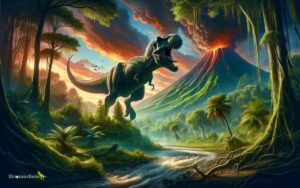What Dinosaur Was the Most Dangerous
While some may argue that size alone determines the level of danger a dinosaur posed, it's the combination of physical attributes, hunting strategies, and environmental adaptability that truly sets the deadliest apart.
From the towering Tyrannosaurus Rex, known for its sheer power and bite force, to the cunning Velociraptor, whose intelligence and pack hunting tactics made it a formidable predator, the debate over which dinosaur was the most dangerous is far from settled.
Add in the aquatic prowess of Spinosaurus, the brute strength of Allosaurus, and the lightning-fast assaults of Carnotaurus, and one finds themselves at the precipice of a fascinating exploration into prehistoric peril.
Key Takeaways
- Tyrannosaurus Rex had the strongest bite force among terrestrial animals, making it a formidable predator.
- Velociraptor's intelligence and pack hunting techniques allowed it to take down larger prey.
- Spinosaurus, the largest carnivorous dinosaur, specialized in aquatic hunting, showing adaptability in predation.
- Carnotaurus' remarkable speed and agility made it capable of high-speed chases and ambushes.
Tyrannosaurus Rex: Apex Predator
Tyrannosaurus Rex, towering with ferocity, reigned as the apex predator of its ecosystem, employing its massive jaws and sharp teeth to dominate prey and rivals alike. This formidable dinosaur, often abbreviated as T. rex, lived during the late Cretaceous period, approximately 68 to 66 million years ago.
Its robust physique included powerful hind limbs that supported its colossal body, while its relatively short arms, though often ridiculed, were muscular and capable of grasping prey. Scientists estimate that T. rex could exert one of the strongest bite forces among all terrestrial animals, enabling it to crush bone and consume its meals efficiently.
This carnivorous behemoth's sensory abilities were also highly developed, with keen eyesight and a refined sense of smell, further cementing its status as a top predator in its prehistoric habitat.
Velociraptor: Cunning Hunter
Velociraptors, renowned for their intelligence and agility, represented a stark contrast to the brute force of larger predators like T. rex, employing sophisticated hunting strategies to outmaneuver prey. These smaller dinosaurs, about the size of a turkey, weren't reliant on sheer strength but on their sharp claws, keen senses, and remarkable speed.
They're believed to have hunted in packs, a tactic that suggests advanced social behavior and strategic planning not seen in many of their contemporaries. This pack hunting method allowed them to take down prey much larger than themselves, showcasing their ability to collaborate and execute complex hunting strategies.
Their curved, sickle-shaped claw on each hind foot was a signature weapon, used to slash and incapacitate their prey, demonstrating their role as cunning predators in their ecosystem.
Spinosaurus: River Monster
The Spinosaurus, often dubbed the 'river monster,' stands out as a unique predator that adapted to aquatic environments, showcasing a significant departure from the traditional terrestrial hunting grounds of its contemporaries. This dinosaur, the largest of all known carnivorous dinosaurs, exhibited physical adaptations indicative of a semi-aquatic lifestyle.
Its elongated snout, similar to that of modern crocodilians, and conical teeth were perfect for catching fish. Moreover, the distinctive sail-like structure on its back, though still a subject of scientific debate, might've played a role in thermoregulation or mating displays, further highlighting its adaptation to a life primarily spent in water.
Such features underscore Spinosaurus's niche as a formidable predator, not on land, but within the ancient rivers it once prowled, setting it apart in the dinosaur kingdom.
Allosaurus: Jurassic Juggernaut
Among the apex predators of the Jurassic period, Allosaurus stood out for its formidable hunting skills and anatomical adaptations that allowed it to dominate its prehistoric environment.
- Powerful Jaws: Its jaw structure, filled with sharp teeth, was perfect for tearing through the flesh of its prey.
- Large Size: Measuring up to 39 feet long, Allosaurus was one of the largest predators of its time.
- Strong Legs: Its powerful legs enabled quick sprints to ambush prey.
- Binocular Vision: This feature allowed for improved depth perception, crucial for hunting.
- Adaptable Hunter: Allosaurus could potentially hunt in packs or alone, showing a flexible approach to capturing prey.
These traits made Allosaurus a top predator, adept at exploiting various preys within its Jurassic world.
Carnotaurus: Speedy Assault
In the Late Cretaceous period, Carnotaurus stood out for its remarkable speed and agility, setting it apart from other predators of its time. This dinosaur's design was highly adapted for quick assaults, featuring strong hind legs that allowed for rapid bursts of speed and a streamlined body that minimized air resistance.
Its skull was equipped with large, forward-facing eyes, providing excellent depth perception for targeting prey. Unlike the bulky tyrannosaurs, Carnotaurus had relatively small arms, suggesting it relied heavily on its bite and speed for hunting. Scientists believe its powerful jaw and sharp teeth could deliver fatal blows to its victims swiftly.
This combination of attributes made Carnotaurus a formidable predator, capable of executing high-speed chases and ambushes with lethal efficiency.
Conclusion
In the prehistoric battle for supremacy, the Tyrannosaurus Rex reigned supreme as the apex predator, overshadowing others with its sheer size and strength.
Velociraptors, with their cunning strategies, pale in comparison to the T-Rex's brute force.
The Spinosaurus, a formidable river monster, and the Allosaurus, a Jurassic juggernaut, also fall short.
Even the swift Carnotaurus couldn't outrun the T-Rex's dominance.
In a world where might makes right, the T-Rex was the undisputed king, making it the most dangerous dinosaur in an ancient game of thrones.




